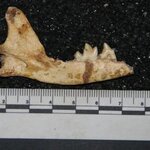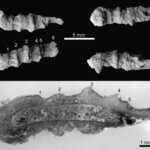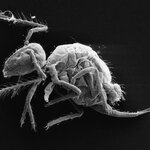Paleontology

The remains of a calcified ovarian teratoma in the pelvis of the skeleton of a woman from the Roman era confirms the presence in antiquity of this type of tumor - formed by the remains of tissues or organs, which are difficult to locate during the examination of ancient remains.
Inside the small round mass, four teeth and a small piece of bone were found.
Teratomas are usually benign and contain remains of organic material, such as hair, teeth, bones and other tissues. There are no references in the literature to ovarian teratomas in ancient remains like those found in this study, led…

Fossilized teeth have led to identification of at least 23 species of small meat-eating dinosaurs that roamed western Canada and the United States between 85 and 65 million years ago, a large increase from the 7 species of small two-legged meat-eating dinosaurs from the North American west that had previously been identified.
The researchers examined a massive dataset of fossil teeth that included samples from members of the families to which Velociraptor and Troodon (possibly the brainiest dinosaur) belong.
The researchers say the huge increase in the number of small meat-eating species to…

Researchers have announced the discovery of a two million year old fossil fox at the now renowned archaeological site of Malapa in the Cradle of Humankind World Heritage Site.
The previously unknown species of fox is named Vulpes Skinneri, for the recently deceased South African mammalogist and ecologist Prof. John Skinner of the University of Pretoria.
The site of Malapa, discovered in 2008, has yielded one of the most extraordinary fossil assemblages in the African record, including skeletons of a new species of human ancestor named Australopithecus sediba, first described in…

Recently on Science Codex there appeared A new
fossil species found in Spain, which on reading turns out to be a new
Cloudinid, an order
of shelled creatures from the late Ediacaran. Cloudina shells are
of interest, showing bore holes made by predators, pointing to an evolutionary
arms race which may have driven the great diversification of phyla in the early
Cambrian.
The paper itself, in Precambrian Research, is entitled
A new
species of Cloudina from the terminal Ediacaran of Spain. What I find
interesting is the figure showing a central canal (presumably a gut) running…

Scientists have found that therizinosaurs defied the sterotype of sensory abilities of plant-eating animals. Their exceptional sensory abilities - smell, hearing and balance - were well developed and might have affected or benefited from an enlarged forebrain, something typically associated with predators.
Therizinosaurs are an unusual group of theropod dinosaurs which lived between 145 and 66 million years ago. Members of the group had evolved to be 23 foot long animals possessing 20 inch long, razor-sharp claws on their forelimbs, elongated necks and a coat of primitive, down-…

Josh Miller likes to call himself a conservation paleobiologist, which makes sense when he explains how he uses bones as up-to-last-season information on contemporary animal populations.
Bones, he says, provide baseline ecological data on animals complementary to aerial counts, adding a historical component to live observation. In his November cover article for the Ecological Society of America's journal Ecology, he assesses elk habitat use in Yellowstone National Park by their bones and antlers, testing his method against several decades of the Park Service's meticulous observations.…

It's not disputed that long necked sauropod dinosaurs were the largest land animals ever to walk the Earth, but why they got so large is a debate.
Was it the nature of the food they ate? While that was considered, skepticism remained. But a group of researchers now argues that the plant ecologists from South Africa who suggested a plant food cause for big dinosaurs were onto something; but scientists confused two different issues in thinking about this problem; namely how much energy is in the plant with how much nitrogen is in the plant – the South African ideas were based…

Researchers have discovered what may be the earliest dinosaur,
Nyasasaurus parringtoni, a creature the size of a Labrador retriever, but with a five foot-long tai. It walked the Earth about 10 million years before more familiar dinosaurs like the small, swift-footed Eoraptor and Herrerasaurus.
The findings mean that the dinosaur lineage appeared 10 million to 15 million years earlier than fossils previously showed, originating in the Middle Triassic rather than in the Late Triassic period. The researchers had one humerus – or upper arm bone – and six vertebrae to work with. They determined…
I like to think of palaeontology as a historical science. We use science as a tool to speculate and test ideas about the history of life on Earth. The alternative is mythology, where we create ideas about the history of life to make a good story, without any grounding in fact.
Take the question, “how did the rhinoceros get its skin”. On the one hand, we have a
scientific study in 2009; that compares folding across many rhinoceroses and examines the blood vessel network. They suggest that the skin evolved its folds to help keep the rhino cool. Rudyard Kipling, however, gives us another…

Three new collembolan species have been discovered in the Maestrazgo caves in Teruel, Spain. Their description has been published in the Zootaxa journal and belong to one of the most ancient animal species on the planet.
The Maestrazgo caves in Teruel are located in a region of the Iberian Range. It is an isolated region with average altitudes between 1,550 meters and 2,000 meters above sea level and and a climate only the Scottish could enjoy, with temperatures ranging from -40°C to -25°C. Inside the
Maestrazgo
caves, the temperatures are a more hospitable 5-11°C.
These animals are…